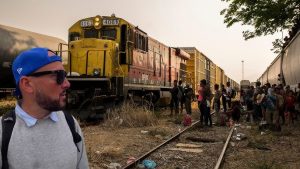As the migrant crisis escalates, the perilous journey on freight trains—known as "The Beast"—unveils the desperate lengths individuals are willing to go in pursuit of hope, amidst heightened dangers and shifting policies.
The Dangerous Journey: Migrants Risk All on "The Beast"

The Dangerous Journey: Migrants Risk All on "The Beast"
Thousands of migrants face harrowing conditions in their quest for a better life, riding the treacherous "Beast" freight train through Mexico.
Migrants making their way through Mexico in hopes of entering the United States confront a series of life-threatening dangers. One of the deadliest methods employed is riding a freight train colloquially named “The Beast” or “La Bestia.” This cargo train, designed primarily for shipping goods rather than carrying passengers, has garnered a notorious reputation due to its associated risks. Each year, thousands of migrants from Central America and Venezuela board these moving train cars, driven by the quest for a better future, all too aware that a single wrong move could lead to disaster.
The journey atop “The Beast” is fraught with peril. Migrants must cling precariously to the tops of the railcars, navigating tight spaces and an ongoing movement that leaves them vulnerable. A security consultant shared harrowing insights with the New York Post, recounted the catastrophic scenarios that can unfold with such overcrowding. “During my talks, I show a video of someone being grievously injured after falling onto the wheels,” he remarked, underscoring the brutal reality of the journey. Alarmingly, reports estimate that about 500,000 individuals gamble their lives on these “death trains” annually, reflecting the desperation that compels these migrations.
Amid rising numbers of migrants, the situation has worsened in light of the anticipated stringent immigration policies under President-elect Donald Trump. In the lead-up to his inauguration, locals near train stations, such as Claudia Rios in Durango, have reported a significant upsurge in migrant activity. She told NewsNation about groups of over 200 individuals trying to board the trains, noting a discernible change in the demeanor of the migrants. “Recently, they seem more aggressive, as if all the kind-hearted migrants have moved on,” she said, pointing to escalating tensions within the groups. Notably, she also observed children and individuals in wheelchairs attempting to board, illustrating the extreme desperation and inherent risks involved.
In Texas, Governor Greg Abbott has initiated a fresh strategy to tackle the migration dilemma. Building on previous tactics such as razor-wire barriers and transporting migrants to sanctuary cities, the latest approach comprises a provocative advertising campaign aimed at deterring potential travelers. Billboards bearing stark messages—such as “How much did you pay to have your daughter raped?” and “Coyotes lie. Don’t put your family at risk”—have been deployed in Mexico and Central America. These messages, presented in multiple languages, aim to dissuade individuals from embarking on the perilous journey. At a press conference in Eagle Pass, Abbott articulated the intent behind the campaign, stating, “The core message is, ‘Do not risk a dangerous trip just to be arrested and deported.’”
Concurrently, human rights organizations, including WOLA, have spotlighted the escalating violence faced by migrants, reporting troubling rises in kidnappings and extortion, labeling this timeframe as one of the most perilous in recent history. WOLA asserts that many Mexican law enforcement officials either turn a blind eye to these crimes or actively participate, exacerbating the hardships migrants endure.
From the harrowing voyage aboard “The Beast” to the chilling warnings emblazoned on billboards, the migrant crisis starkly illustrates the grim realities of desperation and survival. As policies evolve and the human toll mounts, these accounts press urgent considerations regarding the challenges and implications of migration in present-day society.























